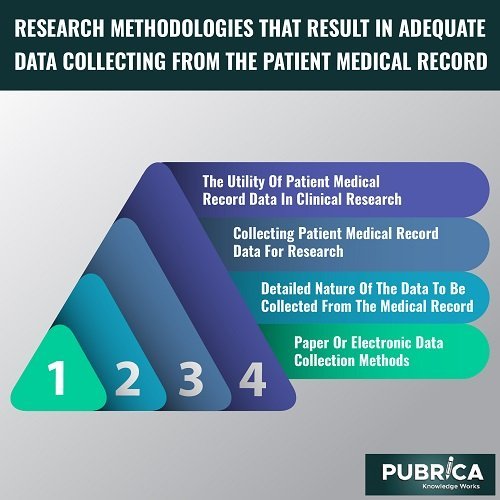
How to Prepare a Perfect Video Abstract for your Research Paper?
March 23, 2022
Deep Learning for Predictive Analytics in Healthcare
March 29, 2022In brief
Clinical research led by nurse investigators frequently includes data gathered from the patient medical record. The rigour of the Health data collection procedures is related to the data’s dependability and, ultimately, the study’s analytical output. Developing a precise data collection instrument, implementing a coding manual, and continual communication with research personnel are all tactics for collecting accurate patient medical records.
Introduction
- Nurses undertaking clinical research usually use the patient medical record as a valuable data source. The patient medical record is frequently used as a primary source of retrospective data for epidemiological analysis. It is widely observed as the gold standard in any study designed to determine demographic factors, clinical data variables, specific aspects of treatment regimens, and, ultimately, patient mortality and morbidity. Reviewing particular sources within the medical record is required for data collection and analysis help. Nursing, physician, and consultation notes, as well as admission and discharge reports, laboratory and diagnostic test results, surgery reports, and other clinical and administrative paperwork, are included. This is not an easy task.
- Before beginning the data gathering endeavour, you must have a solid plan in place. This article describes tactics that may be used to guarantee that data from the medical record is collected as efficiently as possible. Both retrospective and prospective data gathering efforts have effectively proved the effectiveness of these research methodologies. The recommended techniques would equip nurse investigators with particular approaches to help research staff collect patient medical records using a data collection tool.

The Utility of patient medical record data in Clinical Research
At least 25% of scientific publications published in clinical journals use data from patient medical records obtained through retrospective chart review. Retrospective medical record review is a valuable tool for exploring complex research problems to answer using prospective studies. The study of potentially deleterious consequences of exposures and unusual occurrences in exposures when randomisation is impossible are examples of these questions. A medical record review is a helpful tool for examining problems in perinatal research because of the ethical considerations connected with research involving vulnerable individuals.
- Collecting patient medical record data for research
Before beginning any medical record data-gathering project, protocols and criteria for data abstraction from the medical record must be devised. The development and testing of a data collection tool; the use of a coding manual guiding health data collection support services of specific variables from the medical record; and (c) the selection, training, management, and ongoing communication with research staff are all strategies that underpin these protocols and guidelines (i.e., data abstractors)—the research methodologies given to address these three critical aspects of data abstraction from the medical record.
2. Detailed nature of the data to be collected from the medical record
Variables should be reported on the data collection instrument with a short, unequivocal response to ensure validity and accuracy of data gathering. A categorical response may be assigned when numerical data is unavailable or acceptable for a particular research variable. These replies can record surgical or radiological results and absent or unknown factors. For the research team gathering data from the medical record, the categories must be established on the data collection instrument. The internal validity and reproducibility of any retrospective study are dependent on these strategies for standardising the comprehensive nature of the data collected.
3. Paper or electronic data collection methods
A paper document or an electronic record can be used to collect data. Both forms of data-collecting technologies have their own set of advantages and disadvantages. At the point of data collection, which is often in the medical records department across numerous sites, a paper document is frequently more cost-effective and easier to use. The usage of a paper document, on the other hand, necessitates the data being put into an electronic database for analysis. Even under ideal conditions, the data input procedure is rife with the potential for human error, which can distort analysis and research results. Electronic data collecting straight into a database reduces the possibility of data input errors, resulting in more trustworthy image data collection support and analysis. Furthermore, computerised data-collecting makes centralisation and management more effortless.
Strategies for conducting medical record review in clinical nursing research
| Strategy | Specific research actions |
| Development and testing of a data collection tool | Define the study’s objectives and variables.Collaborate with clinical personnel to determine whether relevant data is accessible in the medical record and, if so, where the best source of the data may be found.Construct the data collecting tool to correlate the collected variables to the medical record data. |
| Use of a coding manual | Each variable should be listed and a description of how it should be recorded on the data collecting tool.For each research variable, provide the best data source from the medical record.Pilot test the code instructions and make any necessary revisions. |
| The selection, training, and management of data abstractors | Choose data abstractors with clinical expertise, research training, and the ability to adhere to the study protocol strictly.Ascertain that all data abstractors have completed human subjects protections training and are aware of the necessity of keeping protected patient information private and safe.Utilise electronic and in-person meetings to maintain regular and continuous communication with all data abstractors. |
Data management is critical during any research project. Data management becomes more challenging to maintain while performing studies involving many variables acquired from the medical record across different study locations. The following attributes may be included in the data management protocol: scheduled research team meetings with all data abstractors and the study’s principal investigator (PI) or project director (PD); regular, ongoing communication with the study’s PI and PD to resolve questions and data conflicts; and the formation of an independent committee or panel of experts to serve as consultants to the data abstractors when conflicts arise.
Conclusion
The medical record has long been regarded as a valuable data source for clinical research. When conducting prospective and retrospective clinical studies that use data from the medical record, investigators must adopt a strategic approach to data gathering activities and use a rigorous methodology. A deliberate strategy to conduct retrospective chart reviews in clinical nursing research will generate high-quality data and reliable outcomes. The creation and testing of a data collecting instrument, the use of a coding manual to guide multilingual data collection of specific variables from the medical record, and the selection, training, and management of a research team of data abstractors are all strategies mentioned in this article.
About Pubrica
At Pubrica, we collect data from various sources and perform semantic annotation based on the research questions you want to solve. The vast majority of the data in doctor’s notes are available on Pubrica; electronic medical records, medications, and other related data are also public. Although this is where big data’s golden opportunity in medical care resides, it’s challenging to yield valuable insights due to complex, unstructured, longitudinal, and voluminous data.
References
- Bates, M. C., Rashid, M., Campbell, J. E., Stone, P. A., Broce, M., & Lavigne, P. S. (2006). Factors influencing the need for target vessel revascularisation after renal artery stenting. Journal of Endovascular Therapy, 13(5), 569–577
- Colón-Emeric, C., Schenck, A., Gorospe, J., McArdle, J., Dobson, L., & DePorter, C., et al. (2006). Translating evidence-based falls prevention into clinical practice in nursing facilities: Results and lessons from a quality improvement collaborative. Journal of American Geriatric Society, 54(9), 1414–1418
- Gregory, Katherine E., and Lucy Radovinsky. “Research strategies that result in optimal data collection from the patient medical record.” Applied Nursing Research 25.2 (2012): 108-116.
